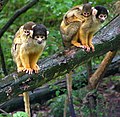Squirrel monkey
| Squirrel monkey | ||||||||||||
|---|---|---|---|---|---|---|---|---|---|---|---|---|

Common squirrel monkey ( Saimiri sciureus ) |
||||||||||||
| Systematics | ||||||||||||
|
||||||||||||
| Scientific name of the subfamily | ||||||||||||
| Saimiriinae | ||||||||||||
| Miller , 1812 | ||||||||||||
| Scientific name of the genus | ||||||||||||
| Saimiri | ||||||||||||
| Voigt , 1831 |
The squirrel monkeys or squirrel monkeys ( Saimiri ) are a genus of primate from the Capuchin family . These relatively small primates are native to Central and South America and live in large groups.
features
Squirrel monkeys reach a head body length of 26 to 36 centimeters, in addition there is a 35 to 43 centimeter long tail. The weight is 700 to 1100 grams, with the males being significantly larger and heavier than the females. These primates get their name from the mask-like face drawing with the black snout. Their fur is dense and short, their back is green, brownish or gray, depending on the species, and their belly is white or light gray. The forearms, lower legs and paws are often orange-yellow in color. The cap on the top of the head is gray-green or black and in some species can also be sex-dimorphic in color.
The hind legs are long, the tibia and fibula often grown together at the lower end. The fingers are very short, the thumb cannot be opposed . The tail is still graspable in young animals, but no longer in adult animals.
The back of the head is elongated, the eye sockets are so close together that there is a hole in the bony wall between the eye sockets, the interorbital window. The area around the muzzle is hairless, the nostrils are on the outside of the nose. The molars have sharp cusps, an adaptation to the food, which is partly made up of insects.
distribution and habitat

Squirrel monkeys are mainly native to the Amazon basin in central South America. Their distribution area extends from southern Colombia and French Guiana to Bolivia and central Brazil . There is also an isolated population in Central America, the Central American squirrel monkey . Their habitat are various forest forms, but they are often found in temporarily flooded river forests and secondary forests .
Way of life
Squirrel monkeys are diurnal tree dwellers who tend to be in the lower tree regions. They usually move on all fours and use the tail for balance, they are very quick and dexterous. They owe their English name to squirrel monkeys to these nimble movements . H. "Squirrel Monkey".
They live in groups of 12 to over 100 animals. Groups are made up of numerous males and females as well as the common young animals. They have an unusual social structure for monkeys: The group is built around the females, who develop a fixed hierarchy. The males are often only on the edge of the group. The group members communicate by whistling and chuckling. The grazing areas are relatively long, the areas of individual groups can overlap.
food
Squirrel monkeys mainly feed on insects and fruits, the proportion of which can vary depending on the season. Hunting insects takes up most of the day (up to 50% of the day), eating the fruit only around 10%. They also eat other parts of the plant such as nectar, flowers, buds and leaves as well as eggs and small vertebrates.
Reproduction and development
Reproduction is seasonal and the breeding period is relatively short. During this time, the males become significantly more aggressive and gain up to 20% in weight. Often, very few males father most of the pups in the group, usually the ones that have put on the most weight. The gestation period is around 150 to 170 days, the births are often synchronized within a group and take place within a few days.
Young animals are relatively heavy at 100 grams. The mother and other females from the group look after the young animals, but the fathers hardly care. After a few months the young will be weaned.
They are sexually mature at around 3 (females) and 5 (males) years. They can live to be over 30 years old in captivity.
Squirrel monkeys and people
The zoo has contributed to the worldwide popularity of the squirrel monkey. Numerous squirrel monkeys were caught and used as pets or in animal experiments up until the 1970s . These practices have declined significantly, although squirrel monkeys are still hunted for their meat in some places. In addition, they are affected by the ongoing deforestation. The Central American and the dark squirrel monkey, both of which are listed by the IUCN as endangered ( vulnerable ), deserve special attention .
The monkey , which is a companion to Pippi Longstocking in Astrid Lindgren's books , was replaced by a squirrel monkey in the films.
Systematics
| Phylogenetic system of squirrel monkeys according to Alfaro et al. 2015 | |||||||||||||||||||||||||||||||||||||||||||||||||||||||||||||||||||||
|---|---|---|---|---|---|---|---|---|---|---|---|---|---|---|---|---|---|---|---|---|---|---|---|---|---|---|---|---|---|---|---|---|---|---|---|---|---|---|---|---|---|---|---|---|---|---|---|---|---|---|---|---|---|---|---|---|---|---|---|---|---|---|---|---|---|---|---|---|---|
|
|||||||||||||||||||||||||||||||||||||||||||||||||||||||||||||||||||||
The squirrel monkeys, together with the capuchin monkeys, make up the family of capuchin-like (Cebidae). The marmosets used to be included in this group, for example in Groves' depiction of the primates in Mammal Species of the World from 2005.
The division of the genus Saimiri into species and subspecies is subject to constant change due to recent studies and findings in the fields of animal geography and phylogenetics. In the past, according to Hershkovitz, they were grouped into two species groups: In the sciureus group, which is named after the common squirrel monkey ( Saimiri sciureus ), the white portion above the eye was described as being raised (" Gothic type"). This feature was contrasted with the white portion above the eyes in the Bolivian squirrel monkey , whose face mask was considered to be rounded (" Romanesque type"). The group of species with similar characteristics was called the boliviensis group. However, this subdivision had to be abandoned because the sciureus group could not be represented monophyletically . Long regarded as a subspecies of the common squirrel monkey, the Collins squirrel monkey is closely related to the Central American squirrel monkey ( Saimiri oerstedii ), which originally belonged to the boliviensis group.
An early relative of the ancestors of all today's squirrel monkeys is the genus Neosaimiri , which is around 12 to 13 million years old and is fossilized from Colombia .
species
- The Bolivian squirrel monkey ( Saimiri boliviensis I. Geoffroy Saint-Hilaire & Blainville, 1834) lives in the southwestern Amazon basin.
- The common squirrel monkey ( Saimiri sciureus (Linnaeus, 1758)) lives in the eastern Amazon basin north of the Amazon.
- The Collins squirrel monkey ( Saimiri collinsi Osgood, 1916) lives in the eastern Amazon basin south of the Amazon and differs from Saimiri sciureus by the yellow top of the head and some morphometric features.
- The dark squirrel monkey ( Saimiri vanzolinii Ayres, 1985) is characterized by its dark fur; it occurs only in a small area at the mouth of the Rio Japurá in the Amazon. It is not, as previously assumed, closely related to the Bolivian squirrel monkey, but to a specific clade of the naked-head squirrel monkey from the east of the Brazilian state of Rondônia .
- The Central American or red-backed squirrel monkey ( Saimiri oerstedii (Reinhardt, 1872)) lives in a small area on the Pacific coast of Costa Rica and Panama.
- The naked- ear squirrel monkey ( Saimiri ustus I. Geoffroy Saint-Hilaire, 1843) differs from the other species in that it has no ear tufts. However, according to molecular genetic studies, there appear to be several species that have not yet been clearly differentiated morphologically. Saimiri madeirae Thomas, 1908 is a synonym for Saimiri ustus . The naked-head squirrel monkeys live in Brazil in the catchment areas of Rio Madeira and Rio Tapajós .
- The Ecuador squirrel monkey ( Saimiri macrodon (Elliot, 1907)) is known from Ecuador, Peru, southern Colombia, and Brazil.
- Under the name Humboldt squirrel monkey ( Saimiri cassiquiarensis (Lesson, 1840)) a group of species is summarized that is currently provisionally divided into two subspecies:
- Saimiri cassiquiarensis cassiquiarensis (Lesson, 1840) is the nominate form. It occurs in the forests of the northwestern Amazon basin in Venezuela and Brazil as far as Colombia.
- Species status was proposed for the Push-squirrel monkey ( Saimiri cassiquiarensis albigena (Push, 1942)) from Colombia in 2009.
The strong fragmentation in squirrel monkeys into eight species is not supported by all scientists. Ruiz-García and colleagues criticize the fragmentation and instead suggest the following species classification:
- Central American squirrel monkey ( Saimiri oerstedii ), with the two subspecies S. o. Oerstedii and S. o. Citrinellus
- Dark squirrel monkey ( Saimiri vanzolinii )
-
Common squirrel monkey ( Saimiri sciureus ), with the two subspecies
- Bolivian squirrel monkey ( Saimiri s. Boliviensis ) and
- S. s. sciureus (this subspecies would also include the push squirrel monkey, the Humboldt squirrel monkey, the Collins squirrel monkey, the Ecuador squirrel monkey, and the naked-eared squirrel monkey).
Alternatively, the common squirrel monkey could be divided into three subspecies
- S. s. boliviensis
- S. s. sciureus (common squirrel monkey and collins squirrel monkey)
- S. s. cassiquiarensis (Humboldt squirrel monkey and Pusch squirrel monkey)
Bolivian squirrel monkey with cubs
The common squirrel monkey has an ogival ("Gothic") white face mask over the eyes.
The Central American squirrel monkey is characterized by its reddish back.
The dark squirrel monkey has a strikingly black head
literature
- Thomas Geissmann : Comparative Primatology. Springer-Verlag, Berlin a. a. 2003, ISBN 3-540-43645-6 .
- Ronald M. Nowak: Walker's Mammals of the World. 6th edition. Johns Hopkins University Press, Baltimore MD 1999, ISBN 0-8018-5789-9 .
Web links
Individual evidence
- ↑ a b c Jessica W. Lynch Alfaro, Jean P. Boubli, FP Paim, CC Ribas, MNF da Silva, MR Messias, F. Röhe, MP Mercês, J. de Sousa e Silva Júnior, CR Silva, GM Pinho, G Koshkarian, MTT Nguyen, ML Harada, RM Rabelo, HL Queiroz, Michael E. Alfaro & IP Farias: Biogeography of squirrel monkeys (genus Saimiri): South-central Amazon origin and rapid pan-Amazonian diversification of a lowland primate. Molecular Phylogenetics and Evolution, 82, Part B, pp. 436-454, January 2015
- ↑ a b following Geissmann (2003)
- ^ AB Rylands, RA & Mittermeier: The diversity of the New World primates (Platyrrhini): Anannotated taxonomy. In: PA Garber, A. Estrada, JC Bicca-Marques, EW Heymann, KB Strier (Eds.): South American Primates: Comparative perspectives in the study of behavior, ecology, and conservation. Pp. 23–54, Springer, New York 2009
- ↑ Anthony B. Rylands, Russell A. Mittermeier, Bruna M. Bezerra, Fernanda P. Paim, Helder L. Queiroz: Family Cebidae - Squirrel Monkeys and Capuchins. In: Russell A. Mittermeier, Anthony B. Rylands, Don E. Wilson (Eds.): Handbook of the Mammals of the World. Volume 3 - Primates. Lynx Edicions, Barcelona 2013, ISBN 978-84-96553-89-7 , p. 393.
- ↑ Don E. Wilson, DeAnn M. Reeder: Mammal Species of the World. Johns Hopkins University Press, 2005, ISBN 0-8018-8221-4 .
- ↑ a b Taxonomy of squirrel monkeys genus Saimiri (Cebidae, platyrrhini): A preliminary report with description of a hitherto unnamed form. 1987
- ↑ a b MP Mercês, Jessica W. Lynch Alfaro, WAS Ferreira, ML Harada, José de Sousa e Silva Júnior: Morphology and mitochondrial phylogenetics reveal that the Amazon River separates two eastern squirrel monkey species: Saimiri sciureus and S. collinsi. Molecular Phylogenetics and Evolution, 82, Part B, pp. 426-435, January 2015 (online from October 20, 2014) doi: 10.1016 / j.ympev.2014.09.020
- ↑ Neosaimiri on fossilworks.org
- ↑ Xyomara Carretero-Pinzón, Manuel Ruiz-García & Thomas Defler: The Taxonomy and Conservation Status of Saimiri sciureus albigena: A Squirrel Monkey Endemic to Colombia. Primate Conservation, 24, pp. 59-64, November 2009
- ↑ Manuel Ruiz-García, Kelly Luengas-Villamil, Norberto Leguizamon, Benoit de Thoisy, Hugo Gálvez: Molecular phylogenetics and phylogeography of all the Saimiri taxa (Cebidae, Primates) inferred from mt COI and COII gene sequences , Primates, 2014, doi: 10.1007 / s10329-014-0452-0




